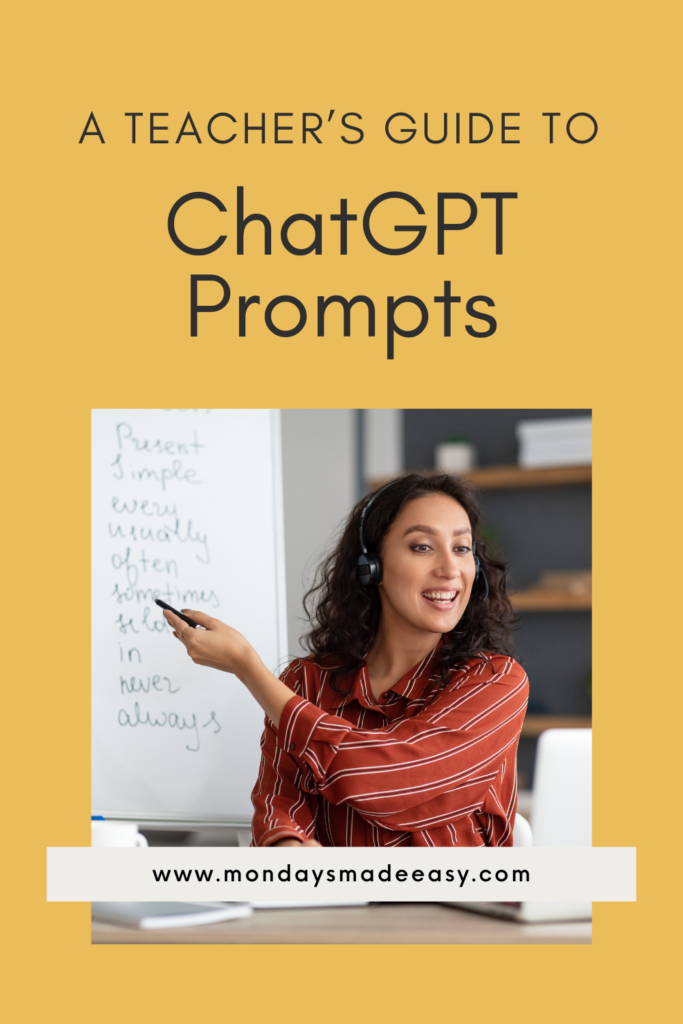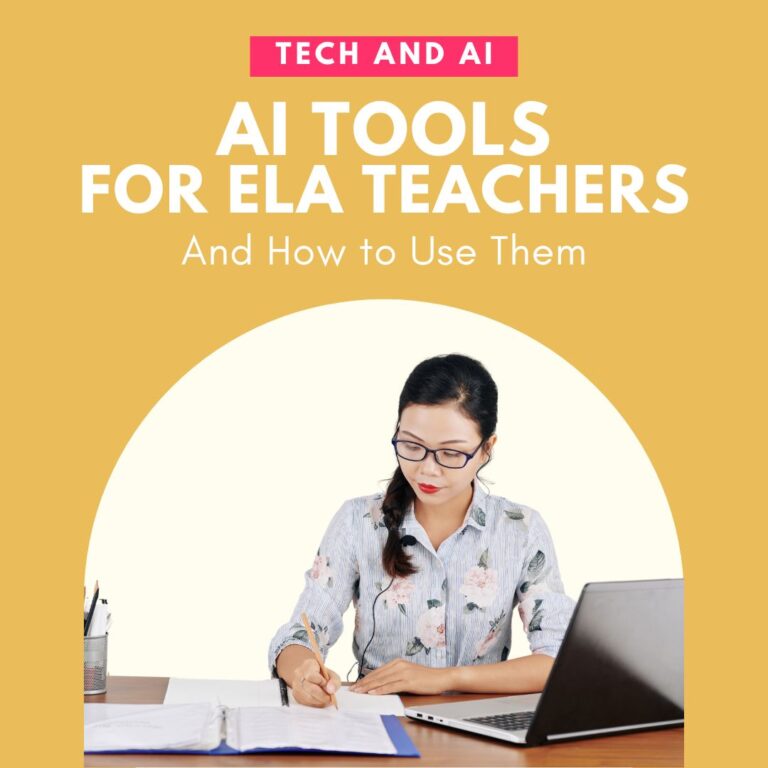Are you interested in ChatGPT prompts for teachers, but you’re unsure where to start? Artificial Intelligence (AI) in education is a hot topic, especially as it relates to plagiarism. It has sparked a debate among educators, parents, and policymakers. While some view AI tools like ChatGPT as revolutionary, others worry about their implications for teaching and learning. In this blog post, I’ll share how ChatGPT can be a powerful ally for teachers. I’ll also share some powerful ChatGPT prompts for teachers in English Language Arts to streamline your workflow!

Engineering ChatGPT Prompts for Teachers
Have you ever provided ChatGPT with a prompt, only to receive a lengthy or generic response? Prompting LLMs is a skill in and of itself. Thankfully, all it takes are a few strategies and a little bit of practice to master ChatGPT prompts for teachers.
When engineering prompts for LLMs, provide as much context as possible. For teachers, context can include subject area, learning frameworks, and curriculum expectations. These parameters will help tailor the response for your individual needs.
It also helps to role play! Assign ChatGPT a role and share information about your students’ learning profiles. You’ll be surprised how a few additional instructions can completely change the way ChatGPT 4 generates responses for you.
Can ChatGPT Write Lesson Plans?
Yes, ChatGPT can write lesson plans! One of the most practical uses of ChatGPT prompts for teachers is its ability to generate comprehensive lesson plans tailored to specific learning goals, grade levels, and curriculum standards. Here’s how you can prompt ChatGPT to create a lesson plan for you:
Example Prompt: “Act as an English Language Arts teacher. Create a 45-minute lesson plan to teach the theme of courage in literature. Your audience is a class of 30 students in grade 8. Your lesson plan must align with the Common Core State Standards and incorporate project-based learning.”
Optional Add-ons:
- “Your lesson plan must align with [curriculum strand].”
- “Your lesson plan must be designed using [framework].”
By providing specific details, you can ensure the lesson plan meets your exact needs and educational standards.
How Can AI Be Used in Language Arts?
AI can be a game-changer in the Language Arts classroom. Through engineering ChatGPT prompts for teachers, you can provide support in various areas, such as:
- Differentiating Assignments and Activities: Tailor assignments to meet the diverse needs of students.
- Generating Rubrics: Create detailed rubrics that align with learning objectives.
- Explaining Challenging Concepts: Simplify complex topics for different grade levels.
- Discovering Related Texts: Recommend texts that align with themes, topics, or literary elements being studied.
Example Prompt for Differentiated Assignments: “Act as an Instructional Coach. Create a differentiated reading activity to evaluate comprehension of the theme of friendship. Your audience is a class of 25 grade 7 students. Your activity should accommodate both visual learners and auditory learners.”

How Do I Use ChatGPT for Teaching?
Using ChatGPT prompts for teachers involves crafting effective instructions. ChatGPT prompts for teachers should provide context and clear instructions. Here are a few strategies to maximize its potential:
- Role Play: Assign ChatGPT a specific role, such as a teacher, instructional coach, or curriculum developer, to guide its responses.
- Provide Context: Include details about the subject area, learning goals, grade level, and student learning profiles.
- Specify Parameters: Outline any specific requirements or constraints to ensure the output is relevant and useful.
ChatGPT Prompts for Teachers in English Language Arts
Engineering effective prompts for ChatGPT can make a significant difference in the quality of responses you receive. Here are some examples to get you started:
- For Lesson Planning: “Act as an English Language Arts teacher. Create a 60-minute lesson plan to teach narrative writing. Your audience is a class of 20 students in grade 9. Your lesson plan must align with the National Curriculum and incorporate collaborative learning.”
- For Differentiating Assignments and Activities: “Act as an Instructional Coach. Create a differentiated writing assignment to evaluate persuasive writing skills. Your audience is a class of 25 grade 10 students. Your activity should accommodate both gifted students and students with learning disabilities.”
- For Generating Rubrics: “Act as a Curriculum Developer. Create a 4-level rubric to evaluate analytical essay writing. You will be assessing grade 11 students on the following criteria: thesis statement, evidence, analysis, and conclusion.”
- For Explaining Challenging Concepts: “Act as a teacher. In 200 words, explain the concept of metaphor to grade 8 students. Write it in a fun and engaging way to appeal to their interest in fantasy stories.”
- For Discovering Related Texts: “Act as an English Language Arts Curriculum Specialist. Recommend five related texts that can be used to teach the theme of resilience. The texts should be appropriate for grade 10 and should include the following genres/forms: novel, short story, poem, play, and memoir. The texts must reflect diverse voices and perspectives.”
The Ethics of AI Use in Education
While AI tools like ChatGPT offer numerous benefits, it’s essential to consider the ethical implications, especially when used with underaged students. Let’s take a look at some ethical considerations:

Ensure Privacy
Protect student data and avoid sharing sensitive information with AI tools. Privacy is a paramount concern when using AI in education. Teachers must ensure that they are not inadvertently exposing sensitive student data. Here’s how to ensure privacy is protected when using ChatGPT prompts for teachers:
- Data Anonymization: Whenever possible, anonymize student data before inputting it into AI tools. Remove identifiable information to minimize privacy risks.
- Secure Platforms: Use AI tools that comply with data protection regulations, such as GDPR or FERPA. These tools often have built-in safeguards to protect user data.
- Parental Consent: For younger students, ensure that parents are informed and have given consent for their children’s data to be used with AI tools.
Educator Training: Administrators should provide training for teachers on best practices for data privacy and how to use AI tools responsibly.
Maintain Academic Integrity
Use AI to support, not replace, traditional teaching methods and critical thinking. AI can be a powerful assistant in the classroom, but it should complement rather than substitute traditional educational practices. Here’s how to maintain academic integrity when using ChatGPT prompts for teachers:
- Balance: Integrate AI tools in a way that supports lesson plans and enhances learning, but still encourages students to engage in critical thinking and problem-solving.
- Originality: Encourage students to use AI as a resource for ideas and inspiration, but ensure they understand the importance of original thought and work.
- Ethical Use: Teach students about the ethical use of AI, including the importance of citing AI-generated content and understanding the tool’s limitations.
Assessment: Use AI-generated materials as supplementary resources while relying on traditional assessment methods to evaluate students’ understanding and skills.
Promote Digital Literacy
Educate students about AI, its capabilities, and its limitations, fostering responsible use of technology. To prepare students for a future where AI is ubiquitous, it’s essential to promote digital literacy. Here’s how you can foster responsible use of AI technology while using ChatGPT prompts for teachers:
- Understanding AI: Teach students what AI is, how it works, and its various applications. Help them understand both the potential benefits and the limitations of AI tools.
- Critical Evaluation: Encourage students to critically evaluate AI-generated content. They should learn to question the accuracy, bias, and relevance of the information provided by AI.
- Responsible Use: Instill a sense of responsibility in students regarding the use of AI. This includes respecting privacy, avoiding misuse, and understanding the ethical implications of AI.
- Hands-On Experience: Provide opportunities for students to experiment with AI tools under guided supervision. This hands-on experience can demystify AI and build confidence in using technology effectively.
By considering these ethical guidelines, teachers can ensure that the integration of AI tools like ChatGPT into the classroom is done responsibly, maximizing benefits while minimizing risks.

ChatGPT Prompts for Teachers: Tying It All Together
ChatGPT is a versatile tool that can assist English Language Arts teachers in numerous ways, from lesson planning and differentiating assignments to generating rubrics and explaining complex concepts. By crafting detailed ChatGPT prompts for teachers and considering ethical guidelines, you can leverage AI to enhance your teaching practice and better support your students. If you found this blog post helpful, be sure to join the mailing list and follow along on Instagram!


